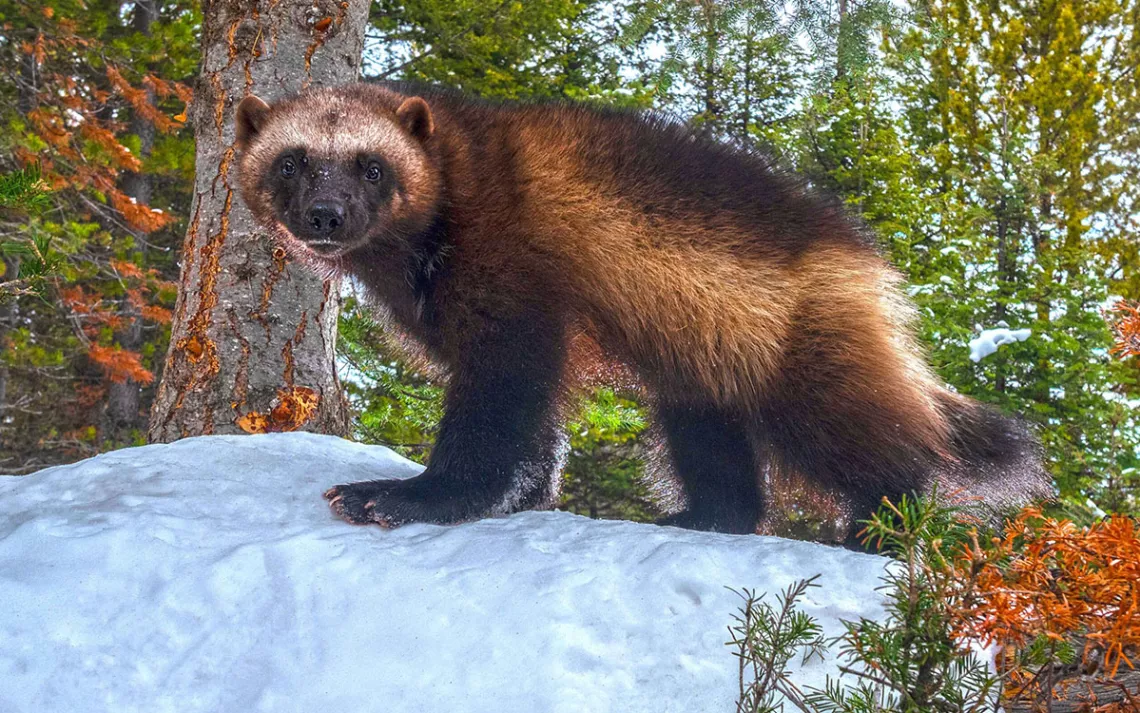Biden Administration Provides a Lifeline to Threatened Wolverines
They’re now officially listed under the ESA—but still not entirely protected

Photo by Kalon Baughan
At long last, on November 29 the US Fish and Wildlife Service moved to protect wolverines under the Endangered Species Act, listing the mustelid as threatened throughout the lower 48 states. (The wolverine population in Alaska is relatively healthy.) But with as few as 300 roaming the wild corners of the West, including the Northern Rockies, Cascades, and Wallowa Mountains, the decision to protect them was a no-brainer for conservationists. Nevertheless, it's taken federal officials 10 years, a review of hundreds of studies, and at least six lawsuits to conclude that these snow-dependent members of the weasel family are worthy of protection.
The ESA listing means that wolverines will be largely protected from human-caused threats such as hunting. Federal agencies will also have to consult with the Fish and Wildlife Service if their projects pose a danger to wolverine conservation. And wolverines will get a recovery plan, which will provide a road map to successfully restoring populations throughout their range.
Conservation groups celebrated the decision as a vital win that will be crucial to sustaining wolverine populations south of Canada into the future. But some are concerned about two glaring exemptions for “incidental take”—the unintentional (but expected) harm or killing of wolverines. These exemptions fall under a provision called the 4(d) rule. One allows fur trappers to kill or harm wolverines in the course of legally trapping other species; the other covers forest managers conducting fire-prevention activities.
Andrea Zaccardi from the Center for Biological Diversity fears these loopholes could threaten populations already barreling toward extinction.
“Trapping does present a threat to wolverines, and recent changes in Idaho and Montana that allow baiting and snaring of wolves could increase the risk of wolverines falling prey to traps spread across the landscape,” she said. Likewise, she added, the Forest Service exception “is too broad, and should be limited to prescribed burns and not include any mechanical logging, which can damage areas wolverines need for denning, which have already been reduced by climate change.”
Well into the 20th century, wolverines were wiped out by predator extermination campaigns led by the US government at the behest of ranchers. Unfortunately for wolverines, which eat lots of carrion, poison was frequently left in carcasses intended for wolves and coyotes. Rural hatred for predators in general remains to this day and, with climate change and habitat destruction, contributes to wolverine decline. At least 10 wolverines have been caught in traps intended for other species since Montana outlawed wolverine trapping in 2012, and in November, someone illegally shot a wolverine and left it to rot. In neighboring Idaho, at least 11 wolverines have been reported being incidentally caught in traps since 1995, with three of them dying.
“Given this extremely depressed level of populations,” said Jeff Abrams from the Idaho Conservation League, “any significant amount of incidental take could be regarded by geneticists, by population researchers as meaningful.”
According to the Fish and Wildlife Service, that low genetic diversity can also be exacerbated if wolverine movement is hindered by disturbance from motorized vehicles like snowmobiles. Abrams hopes federal wildlife officials will work closely with states to gather data on winter travel and backcountry recreation to avoid and minimize those stresses on wolverines. He also cites mining as a big concern that the agency completely elided in its listing announcement. In Idaho alone, there are currently over 1,500 mining projects.
“We have a proposal here called the Stibnite Gold Project, which would essentially introduce a year-round industrial byway at 8,000 feet directly adjacent to the Frank Church River of No Return wilderness area,” Abrams said. “The Idaho Conservation League is concerned that it could compromise the condition of the existing wolverine populations in the area and create added stresses to animals using, residing in, or migrating through that habitat.”
The Idaho Conservation League, Earthjustice, Defenders of Wildlife, the Sierra Club, Center for Biological Diversity, and others are now combing through the listing decision and proposed 4(d) rule. A public comment period started November 30 on the proposed 4(d) rule and is open for 60 days.
Despite these considerations, many elements of the plan have left the groups feeling optimistic. Beyond the basic protections that will now be afforded to wolverines, further conservation measures, such as reintroductions, are now on the horizon, with Colorado being an ideal candidate. There was a previous plan to bring wolverines back to the state, but it was scuttled in 2014 when the USFWS decided not to list the species. Now that their protections are guaranteed, this could be a valuable tool for conservation.
“This listing is a key part of moving that forward. So I'm pleased from that perspective,” Timothy Preso, managing attorney of the Biodiversity Defense Program at Earthjustice, said. “There's a lot of positives here for bringing back a wildlife species that was really kind of teetering on the brink.”
 The Magazine of The Sierra Club
The Magazine of The Sierra Club



